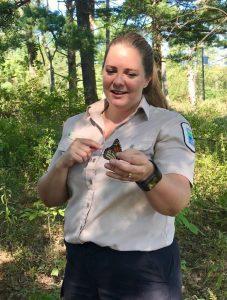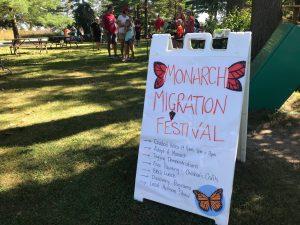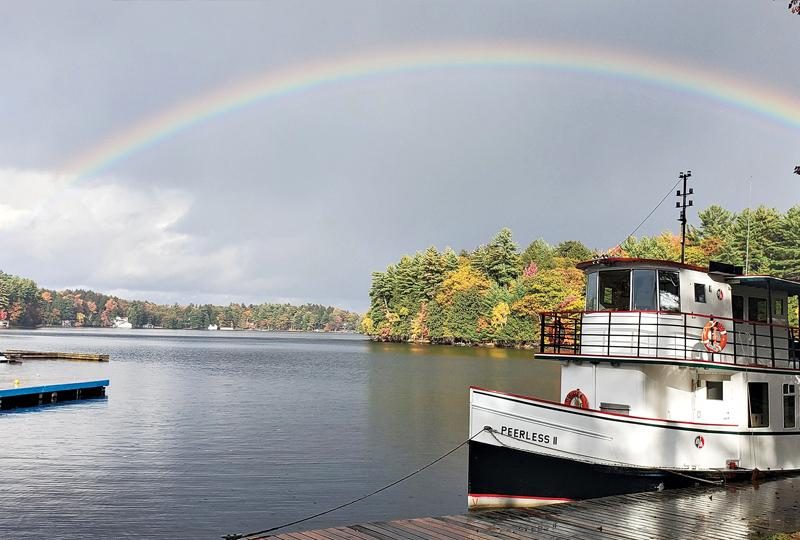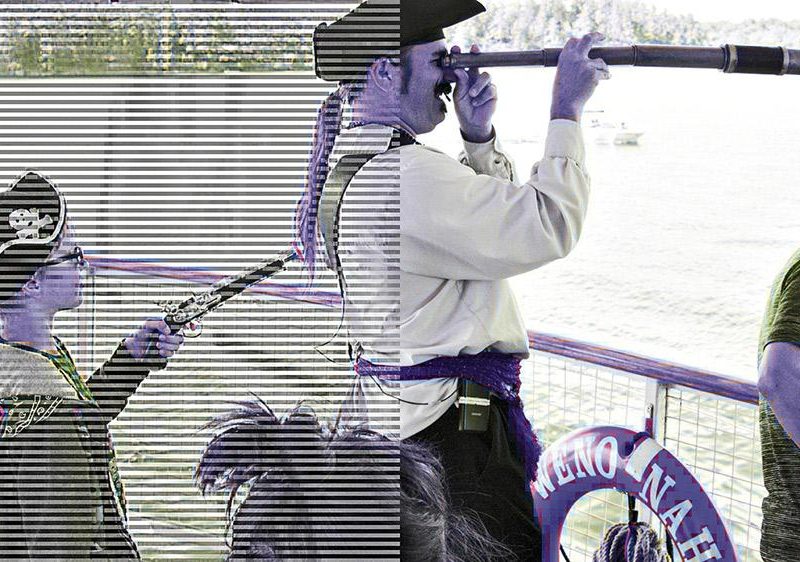
In search of Ontario’s Monarchs
By Carol Patterson
Sweat trickled down my back as I got off the Parks Canada shuttle and started the short walk to the tip of Point Pelee National Park, the most southerly point of mainland Canada. The forest hummed with the sound of insects, columns of midges rose above the trees and flies clung to my legs and arms. I had come in search of monarch butterflies, their migration south from Canada to Mexico the longest of any butterfly and a source of mystery.
Searching for a butterfly may not seem at first blush a true quest but it turned out there’s enough suffering to make this a legitimate challenge. It took two taxis, two plane rides and a three-hour drive to reach my destination.
 Pulling up to the Point Pelee National Park entrance a sign read “Stable flies are biting”. What’s a stable fly? I wondered. I should have asked, “What kind of bug merits its own sign?” But Point Pelee is ground zero for butterfly-chasing tourists in fall so I carried on.
Pulling up to the Point Pelee National Park entrance a sign read “Stable flies are biting”. What’s a stable fly? I wondered. I should have asked, “What kind of bug merits its own sign?” But Point Pelee is ground zero for butterfly-chasing tourists in fall so I carried on.
Monarch butterflies follow the most southerly tip of mainland Canada to Lake Erie, fly over Pelee Island and then southwest to Mexico. This migration is one of the world’s greatest animal mysteries with the superstar flyers covering about 4,800 kilometres and all of them are doing it for the first time.
Most monarchs live only two to six weeks as adult butterflies. After they mate and lay eggs they die and their young hatch, grow as a caterpillar by munching on milkweed before transforming into a butterfly. It takes four generations to complete the trip north from Mexico to Canada!
When it is time to return a generation of butterflies is born that are driven to eat, not mate. It is this generation that will make the arduous trip south, gathering for several months in Mexican forests at 3,000-metre elevation where cool temps preserve them in a type of stupor. When the weather warms up they lay eggs and die.
Lacking resources to follow them to Mexico I decided to see them off in southern Ontario. I checked into a comfy Parks Canada oTENTik before grabbing my binoculars and camera and heading to the tip of Point Pelee.
Wearing pants and a long-sleeve shirt I applied liberal amounts of bug spray although I’d been warned neither was effective against stable flies. Several people boarded the park shuttle next to me dressed in shorts and t-shirts. One concerned mother yelled, “Do you know what you’re getting into?”
“Yes, we’ve been there before,” someone replied. From a seat behind me a young boy uttered, “We are hoping the flies are asleep.” I was too.
After unloading from the shuttle I strode to the point. Scanning the treetops I spotted a bright orange and black butterfly drift by. It was a monarch! Watching it was Darlene Burgess, the evening monarch monitor.
She stood unperturbed by flies clinging to her jeans, a counter in her hand as she scanned the sky. “That’s 250 so far today,” she revealed, “these ones won’t leave tonight but if you watch where they land you might spot a roost (a gathering of butterflies). They tend to cluster more towards sunset.”
To see large concentrations of monarchs you need bad weather. Wind or precipitation stops the migration as the butterflies wait for better conditions. Above me were clear blue skies and little wind so I spotted my butterflies one or two at a time, fluttering across the sky like tangerine will-o’-the-wisps.
The next day I returned to the Point Pelee tip to look for more butterflies, scratching stable fly bites I’d amassed despite my best efforts. The point was crowded with people looking for butterflies and snapping selfies but few noticed the solitary monarchs flitting overhead. This migration doesn’t have the visual footprint of a million wildebeest but it’s still worth watching.
Lake Erie lapped against the sand as I gazed south to Ohio. A monarch flitted past, following the sandy edge to the tip of land. It flapped bravely upwards and disappeared towards Pelee Island. Tears welled in my eyes as I realized it had started its dangerous trip to Mexico, following a siren call to a place it had never seen. Its bright colour was protection from bird predation but luck, its only weapon against bad weather and habitat loss.

Wanting to see more Monarchs, the next day I headed to Rondeau Provincial Park and the annual Monarch Migration Festival. Dozens of people spilled over the Visitor Center lawn, several kids sported butterflies painted on their cheeks.
I joined a long queue where eager bug lovers were sponsoring monarchs and attaching a tag to ‘their’ butterfly. Canadian scientist Dr. Fred Urquhart started tagging monarchs to unravel the mystery on where they went in winter. He discovered monarchs living east of the Rockies went to Mexico, the monarchs west of the Rockies, to California.
In 1992 a large citizen science project, Monarch Watch Tagging Project was launched and now volunteers use more than a quarter million tags to learn even more about the butterflies.
I was eager to get my hands on one of these orange aviators. I paid $10 and park interpreter Caitlin Sparks carefully plucked a butterfly (gathered earlier) from the net enclosure and opened its wings to sex it (males have two brown spots on their hind wings). This butterfly was a female. Her tag read YAX 170 but I named her Molly after Molly Reilly, a Canadian female pilot in the Aviation Hall of Fame.
Sparks attached the tiny tag while I gingerly held Molly’s wings. We posed for a picture and I released my butterfly. Molly wasn’t in a hurry to leave so I left her on some tasty goldenrod to rest.
Once the monarchs that return to Mexico die, farmers pick through piles of dead insects looking for tags. They are paid a bounty for each one they send back. Information from returned tags helps scientists, and sponsors get a letter saying their butterfly made it.
Knowing Molly might become an insect pen pal (albeit only after dying) connected me in a personal way to these brave creatures and their mysterious migration. I wished Molly bon voyage, satisfied my quest had been successful, stable flies be darned.







